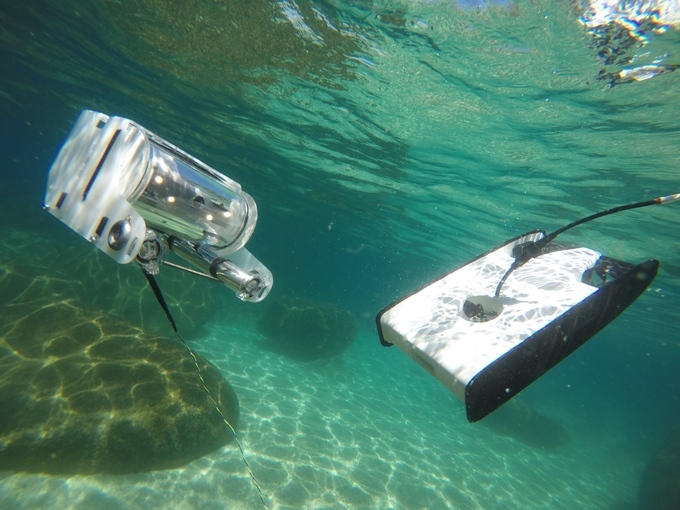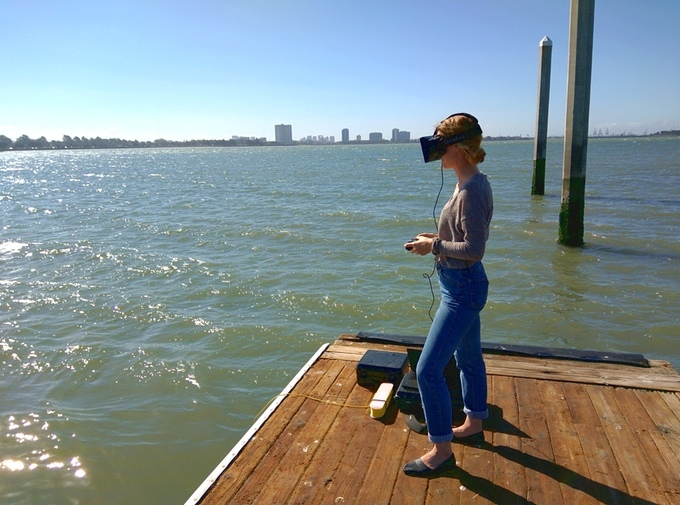OpenROV Trident Submarine Drone
The OpenROV team (Open Source Underwater Robot) launched the Trident submarine drone. This small drone is incredibly agile and moves quickly underwater.
According to the developers:

The Trident drone has a unique design that combines multifunctionality, ROV control (remotely controlled vehicles) and the effectiveness of AUV (autonomous underwater vehicle). He is able to deftly and very accurately maneuver in a limited space, penetrate places inaccessible to other devices. In addition, Trident is easy to use and ready to go.

Trident is the second project of the team. The guys first appeared on Kickstarter in 2012 with the version of the budget OpenROV underwater drone. One of the main ideas is the availability of an underwater drone for everyone who wants to explore the underwater bottom.

Drones OpenROV 2.8 and Trident
According to one of the organizers of the project:

OpenROV Team
Every detail of Trident's design is thought out to the smallest detail in order to optimize its activity and increase efficiency in any situation. It is the most convenient to use and quickly moves under water. Speed and accuracy are controlled by three inverter brushless motors that rotate the screws. The uniqueness of the three-axis system of the drone makes it easier to control, it can easily be moved from side to side, up or down. Drone

scheme The
underwater drone is equipped with a camera that shoots in Full HD resolution and at a frequency of 30 frames per second. The drone can take photos, shoot videos, as well as create maps of the seabed and three-dimensional models of underwater areas.

Detailed Description Trident
Specifications
Weight - 2.9 kg;
Maximum speed - 2 m / s;
Autonomous operating time - 3 hours;
Maximum immersion depth - 100 m;
Dimensions - 400 mm x 200 mm x 80 mm.

The drone is equipped with LED "headlights" that provide adequate lighting for deep sea or night dives. An elastic cable-cable is connected to the device (possible length: from 25 m to 100 m), with the help of which information is controlled and transmitted. Trident can be controlled via Wi-Fi via a smartphone, tablet or laptop. The drone is framed by a rubber coating that protects its frame in a collision with underwater objects.
The goal of the project is to make the easiest, most intuitive teleobot system of teleobots in operation. Developers have used the latest Internet standards from HTML5 and webRTC to WebVR and WebGL.
Trident Management Software is a publicly available project .


The Trident basic kit includes:
- the Trident drone, which is ready for immersion;
- 25 meters of control cable (you can order a longer cable up to 100 m);
- a buoy with a Wi-Fi module, with which the drone is controlled from the shore or deck of the boat;
- On-board LiFePO4 batteries, operating up to 3 hours, without recharging.
According to the developers:
The type of lighting makes it possible to create a visualization of the underwater bottom, similar to the photogrammetry methods that are used by the program to create work areas of 3D models. As in this example of visualization (expedition in the area of the island of Fiskado, Greece).

When frames are superimposed on top of an air drone, a peculiar “window” is visually created on the sea.

Fiskardo Island Area, Greece (Expedition - Ocean 71)
Trident will become an indispensable tool for fishermen and yacht owners. With it, you can monitor the condition of the underwater parts of ships, find breakdowns, find the most fishing spots and inspect the shipwreck. A drone is its “eyes” under water.

You can control the device using Oculus Rift

Retail pricing for OpenROV Trident is $ 1,199. But those who are the first to join the financing of the project will be able to get a drone for a donation of $ 599. Deliveries of finished models are scheduled for the end of autumn 2016.
According to the developers:
After four years of designing and piloting drones, studying their features and specifics of work, we took a different look at what a real underwater drone should be like.

The Trident drone has a unique design that combines multifunctionality, ROV control (remotely controlled vehicles) and the effectiveness of AUV (autonomous underwater vehicle). He is able to deftly and very accurately maneuver in a limited space, penetrate places inaccessible to other devices. In addition, Trident is easy to use and ready to go.

Trident is the second project of the team. The guys first appeared on Kickstarter in 2012 with the version of the budget OpenROV underwater drone. One of the main ideas is the availability of an underwater drone for everyone who wants to explore the underwater bottom.

Drones OpenROV 2.8 and Trident
According to one of the organizers of the project:
Our first workshop was the most ordinary garage. There we collected an original prototype drone for exploring a cave in Northern California, which is rumored to store lost treasures. We never found gold, but on the other hand, we received many messages from all over the world from those wishing to financially help us in the development of the drone. The Kickstarter project has become a springboard for the company. Since then, we have sent thousands of OpenROV to people from different countries.

OpenROV Team
Characteristics Trident
Every detail of Trident's design is thought out to the smallest detail in order to optimize its activity and increase efficiency in any situation. It is the most convenient to use and quickly moves under water. Speed and accuracy are controlled by three inverter brushless motors that rotate the screws. The uniqueness of the three-axis system of the drone makes it easier to control, it can easily be moved from side to side, up or down. Drone

scheme The
underwater drone is equipped with a camera that shoots in Full HD resolution and at a frequency of 30 frames per second. The drone can take photos, shoot videos, as well as create maps of the seabed and three-dimensional models of underwater areas.

Detailed Description Trident
Specifications
Weight - 2.9 kg;
Maximum speed - 2 m / s;
Autonomous operating time - 3 hours;
Maximum immersion depth - 100 m;
Dimensions - 400 mm x 200 mm x 80 mm.

The drone is equipped with LED "headlights" that provide adequate lighting for deep sea or night dives. An elastic cable-cable is connected to the device (possible length: from 25 m to 100 m), with the help of which information is controlled and transmitted. Trident can be controlled via Wi-Fi via a smartphone, tablet or laptop. The drone is framed by a rubber coating that protects its frame in a collision with underwater objects.
Software
The goal of the project is to make the easiest, most intuitive teleobot system of teleobots in operation. Developers have used the latest Internet standards from HTML5 and webRTC to WebVR and WebGL.
Trident Management Software is a publicly available project .


The Trident basic kit includes:
- the Trident drone, which is ready for immersion;
- 25 meters of control cable (you can order a longer cable up to 100 m);
- a buoy with a Wi-Fi module, with which the drone is controlled from the shore or deck of the boat;
- On-board LiFePO4 batteries, operating up to 3 hours, without recharging.
According to the developers:
We built Trident as a complete and versatile tool for researchers. But we also needed to make sure that the drone was suitable for most utilities.
The type of lighting makes it possible to create a visualization of the underwater bottom, similar to the photogrammetry methods that are used by the program to create work areas of 3D models. As in this example of visualization (expedition in the area of the island of Fiskado, Greece).

When frames are superimposed on top of an air drone, a peculiar “window” is visually created on the sea.

Fiskardo Island Area, Greece (Expedition - Ocean 71)
Trident will become an indispensable tool for fishermen and yacht owners. With it, you can monitor the condition of the underwater parts of ships, find breakdowns, find the most fishing spots and inspect the shipwreck. A drone is its “eyes” under water.

You can control the device using Oculus Rift

Retail pricing for OpenROV Trident is $ 1,199. But those who are the first to join the financing of the project will be able to get a drone for a donation of $ 599. Deliveries of finished models are scheduled for the end of autumn 2016.
